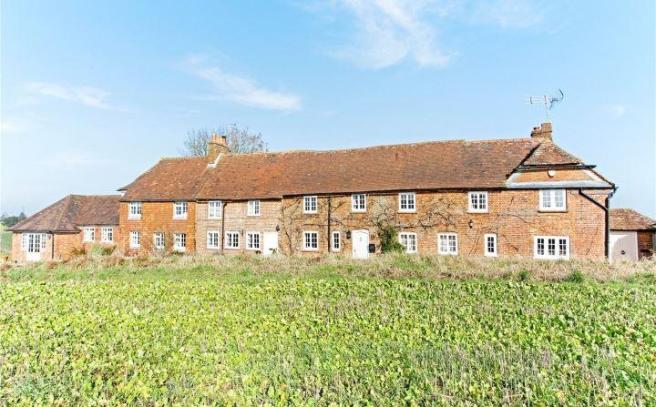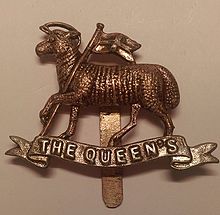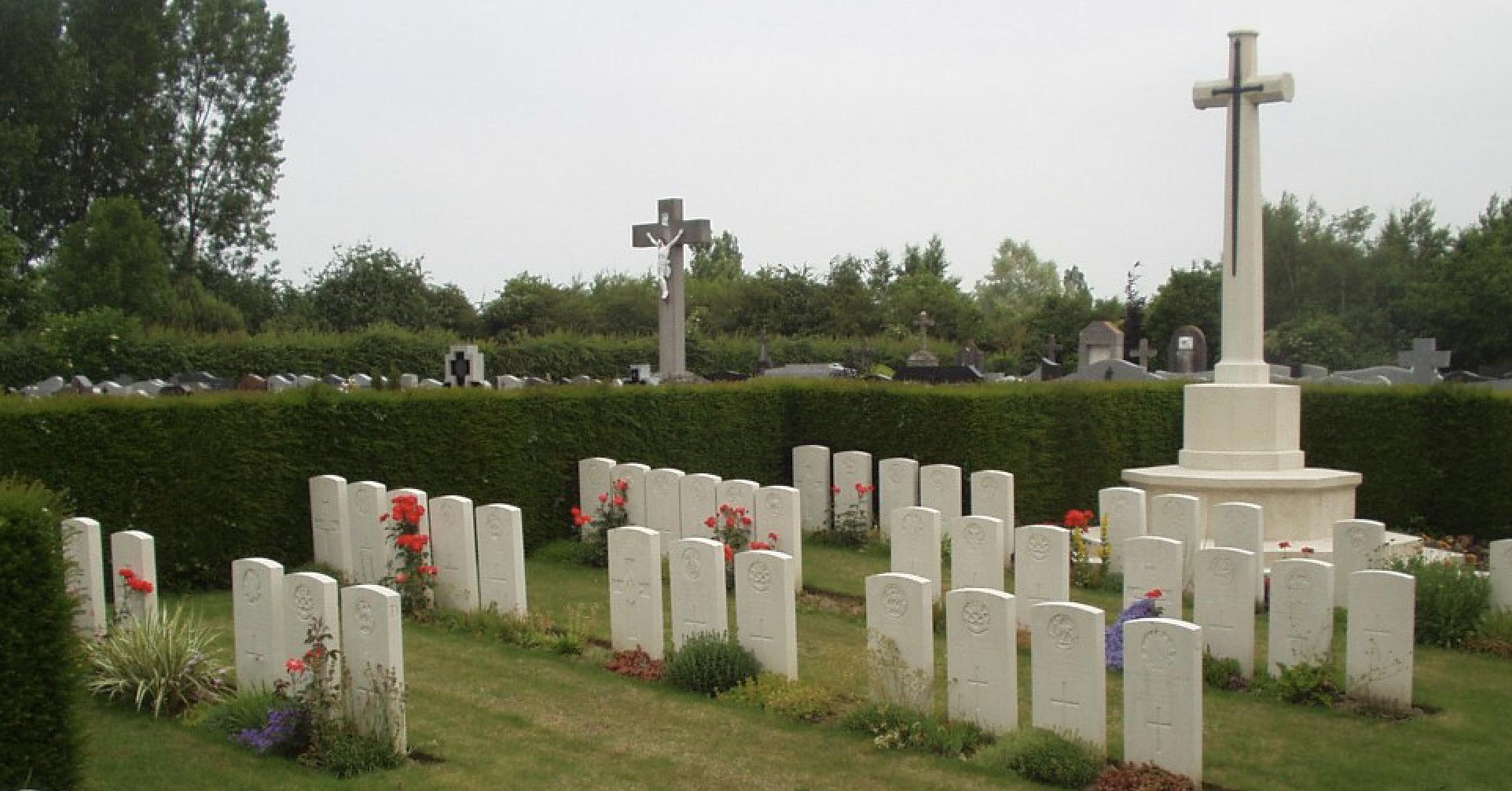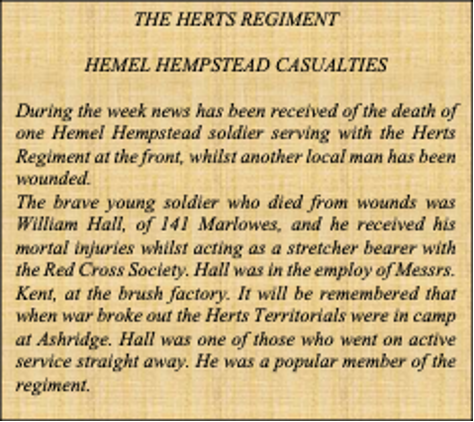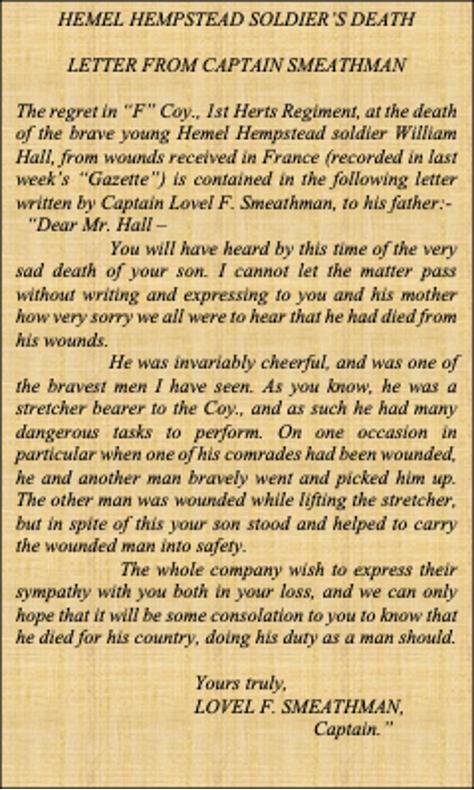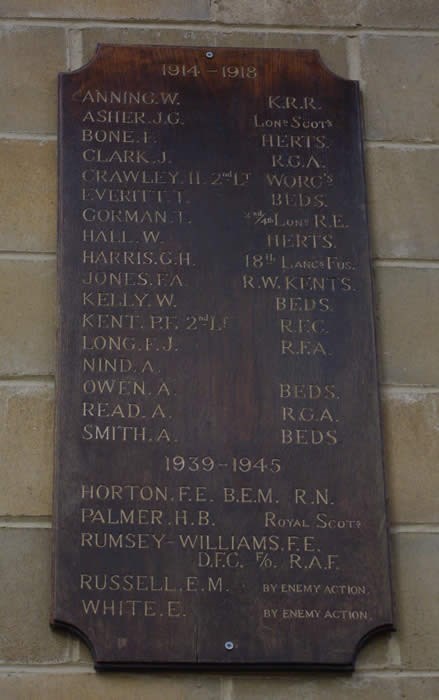Fallen in February 1915:
Arthur Frederick Collis
William Hall
ARTHUR FREDERICK COLLIS
803 Private
2nd The Queen's (Royal West Surrey Regiment)
Died of Wounds Tuesday, 2nd February 1915
Remembered with Honour, Sailly-Sur-La-Lys Churchyard, France, Plot: C.3.
Arthur Frederick Collis was born in July 1891 in Well near
Long Sutton in Hampshire. He was the second child and only son of Fred and
Annie Collis, of Jonathan Kiln Cottages, Crondall, Hampshire. Arthur had four
sisters; Frances who was two years older and three younger girls; Elsie, Violet
and the youngest, Annie.
By the age of 19 in 1911, Arthur was living with his family in Crondall, a small village near Farnham in Hampshire, and like his father Fred, worked as a Waggoner on a nearby farm. A Farm Waggoner looked after the horses under his control and drove them in accordance with whatever work had to be undertaken such as ploughing, reaping and harrowing. Otherwise he drove a horse-drawn heavy four-wheeled wagon, conveying produce and goods to market. It was hard and heavy manual labour.
In Hampshire in 1911 Arthur would have earned an average of approximately 15s 2d per week which included a bonus at harvest time. Minimum wages and hours of work for agricultural labourers were not standardised until 1918 and before that time it was usual for farm employees to work 10-hour days 6 days per week. Arthur would have worked shorter hours during winter, but his weekly wage would have been lower as a result.
Arthur enlisted in The Queen’s (Royal West Surrey) Regiment
attesting on 10th September 1914. The Regiment was the oldest
English line Infantry Regiment and the second only in ‘order of precedence’ in
the British Army after the Royal Scots (The Royal Regiment). It was first
raised in 1661 as The Earl of Peterborough’s Regiment of Foot, by Henry
Mordaunt 2nd Earl of Peterborough.
The 2nd Battalion was in South Africa when war broke out and returned to Britain. It embarked for Belgium aboard the SS Turcoman on the 6th October 1914 and landed at Zeebrugge at dawn on the following day. It formed part of the 22nd Infantry Brigade in the 7th Division and saw action at the First Battle of Ypres. The regiment suffered significant casualties in the battle and it took until early 1915 before it recovered to full strength.
Arthur disembarked in France a month after his enlistment and joined the 2nd Battalion at Merris about 20kms west of Armentières on 11th November 1914. He would spend the next two and a half months either in the trenches or at billets behind the lines working on support and communications trenches.
The 2nd Queen’s war diaries recorded that by late January the battalion was at La Toulette approximately 6kms south west of Armentières and from the 29th January the unit was subject to constant German sniping suffering daily casualties as a result.
On 2nd February 1915 the casualty list read; Killed 1, Wounded 2, Hospital 2. Arthur was the soldier who was killed.
Arthur Collis is Remembered with Honour at Sailly-Sur-La-Lys Churchyard, Nord
Pas-de-Calais where he was interred in Plot: C.3.
The only record of Arthur living in
Hemel Hempstead appeared in the Hemel Gazette on the 12th July 1919,
when a ‘Roll of Honour’ was published listing his address as 38 Herbert Street.
However, this was in fact his Aunt’s address at the time and she appears to be his only connection to the town.
Selina Collis was the younger of his father’s two sisters and she married John Millman at St Paul’s Church in Hemel Hempstead on Christmas Day 1901. John Millman was an Iron Moulder and had come to work in either Boxmoor Iron Works or Joseph Cranstone’s Hemel Hempstead Engineering Company.
Johnathan Kiln Cottages, Crondall, Hants birthplace and childhood home of Arthur Collis
The Queen’s (Royal West Surrey) Regiment Cap Badge World War 1
Sailly-Sur-La-Lys Churchyard, Nord Pas-de-Calais, France (Courtesy: CWGC)
Pte. Arthur Collis' headstone, Sailly-Sur-La-Lys Churchyard, Nord Pas de Calais, France (Courtesy: Traquair Photography 5th Nov. 2017)
They lived at 16 Chapel Street in Hemel with Selina’s children from a previous marriage and by 1919 John and Selina had moved to 38 Herbert Street. They remained in Hemel Hempstead until their deaths in 1936 and 1944 respectively. It would have been at Selina’s request that Arthur was commemorated on the Town War Memorial.
Arthur was 23 years old when he died.
He was eligible for the 1914-15 Star, the British War Medal and the Allied Victory Medal.
WILLIAM HALL
2181 Private
1st Bn., Hertfordshire Regiment
Died of Wounds Sunday, 7th February 1915
Remembered with Honour, Chocques Military Cemetery, France, Plot: I.A.19.
William Hall was the third son of William and Eliza Ann who were living at 66 Queen Street at the time of his birth in early 1893. William was baptised at St Paul’s Church in Hemel Hempstead on 21st July of the same year. He came from a large family and grew up with six brothers and four sisters. In 1911 the Hall family were living at 141 Lower Marlowes in Hemel Hempstead and the census return records William’s parents had a total of twelve children two of whom had died young.
His older brother Alfred was also killed in the Great War in
1918 and his biography appears in this book.
William attended Queen Street school in Hemel Hempstead and in both 1900 and 1901, he was the recipient of a cash prize for his good attendance. He was awarded 1s 6d on each occasion for 432 and 401 ‘full attendances’ respectively. National Schools had roll calls twice each day, one in the morning and again in the afternoon and each one was counted as an ‘attendance’, so William had an almost perfect record during these two school years. This at a time when children were often away from school for a variety of reasons, such as; harvesting, truancy and ‘blackberrying’!
William and three of his sisters; Rebecca, Ethel and Rose were working as Brush Factory Hands in 1911 at Kent Brushes in Apsley, and both William and his sister Rose were ‘Shapers’. Shaping was part of the finishing process in brush manufacturing which included sanding, staining and polishing and was often considered a specialist job in the industry.
GB Kent & Sons was established in 1777, by William Kent in the reign of George lll manufacturing a range of brushes of the very best workmanship and moving to Apsley in 1901. Kent workers made hundreds of thousands of brushes for the War Office during the Great War, including a soldier’s kit featuring; hair, tooth, shaving, cloth, shoe blacking, shoe polishing and button brushes. Large quantities of horse brushes were also supplied for the army.
During the four-year conflict, many of Kent’s employees joined the colours, of which seventeen lost their lives. Their names are recorded on a special memorial plaque at the current London Road factory in Apsley.
William was a member of the Hertfordshire Territorial Force and he and his older brother Alfred joined the Force on 30th May 1913. Their attesting officer was 2nd Lieutenant Harcourt Snowden who was killed only a month before William.
The Territorial Force was camped at Ashridge when war broke out, and William was amongst the first volunteers for foreign service from Hemel Hempstead. He embarked for France with 1/1st Battalion Hertfordshire Regiment as it joined the British Expeditionary Force in France on the 6th November 1914 serving in the trenches during the closing stages of the First Ypres. Later that month the battalion joined the 4th (Guards) Brigade of the 2nd Division.
In January 1915 Lieutenant Colonel Croft took command and the following month the Battalion supported the 1st Irish and 3rd Coldstream Guards in their seizure of the Brickstacks position at Cuinchy, 5 miles east of Béthune.
The Battalion war diaries recorded William’s death on 7th February 1915.
"7-2-15. Two Companies under Captain Jones [Edgar Montague JONES] reported to O.C. 3rd Battalion Coldstream Guards at 6.30am at CUINCHY. No.2 Coy sent 2 platoons to Fire Trench. 1 man killed in No.1 Company in support [Comment; Lance Corporal 86 Edward David NEWALL killed and Private 2181 William HALL died of wounds later that day]. Lieut. J. PAWLE dangerously wounded."
William’s death was announced in the Hemel Gazette on 20th February 1915. (see extract)
His father subsequently received a touching letter from
Captain Lovel F. Smeathman which attested to William’s bravery and popularity.
The Gazette published the letter in its edition on 27th February
1915. (see extract)
William is Remembered with Honour at Chocques Military Cemetery, Pas-de-Calais, France and is interred in plot I.A.19.
At the time he was killed William’s parents were living at 2, Frogmore Crescent, Apsley End.
William is also commemorated on a War Memorial Plaque at Kent Brushes in Apsley.
William was 21 years old when he died. He was eligible for the 1914-15 Star, the British War Medal and the Allied Victory Medal.
Chocques Military Cemetery, Pas-de-Calais, France (Courtesy: CWGC)
Pte W. Hall (Courtesy: The Hertfordshire, Hemel Hempstead Gazette and West Herts Advertiser)
Kent Brushes c.1910 (Public Domain)
Extract from the Hertfordshire, Hemel Hempstead Gazette and West Herts Advertiser, 20th Feb. 1915
Extract from the Hertfordshire, Hemel Hempstead Gazette and West Herts Advertiser, 27th Feb. 1915
Kent Brushes War Memorial Plaque (Public Domain)
